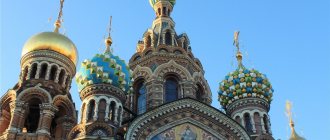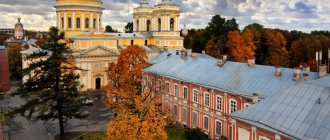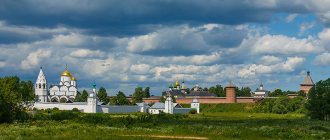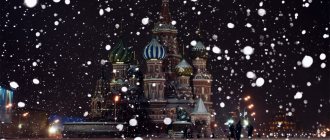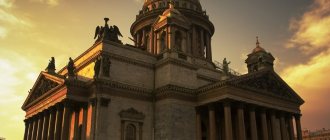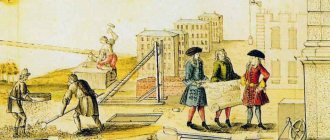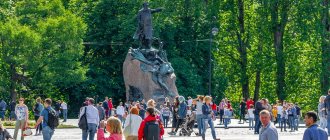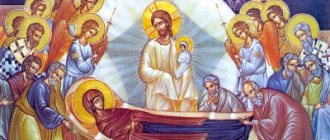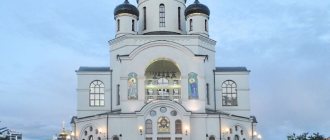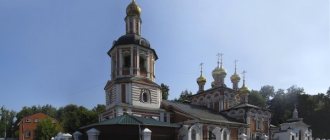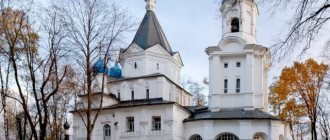St. Nicholas Naval Cathedral in St. Petersburg is located on the banks of the Kryukov Canal. It is a magnificent monument of the Baroque architectural style. St. Nicholas Church of the Epiphany consists of two churches - lower and upper. The lower church is consecrated in the name of St. Nicholas the Wonderworker of Myra - the patron saint of all travelers, including by sea. The upper church was consecrated in the name of the Epiphany of the Lord. Therefore, the full name of the temple is St. Nicholas Cathedral. Its construction was completed in 1762.
The history of the creation of St. Nicholas Naval Cathedral in St. Petersburg
According to legend, Peter the Great, who visited Astrakhan, admired the beauty of the Assumption Cathedral and wished to see the same temple in the capital. But no such temple was built during Peter’s lifetime.
In the 18th century, on the site of Nikolskaya Square there was a parade ground of the Marine Regimental Court. For the Life Guards naval crew, a wooden church was built in the center of the square in 1743. However, due to the humid climate, the church began to quickly deteriorate. Then, at the request of Prince M. Golitsyn to Empress Elizabeth, it was decided to build a stone church modeled on the one in Astrakhan. It was supposed to become the main temple of the Russian fleet.
The project was carried out by architect S.I. Chevakinsky. Construction began in July 1753. A little later, a bell tower is erected to the west of the temple. It was built in 1758, before the church. The architect foresaw the extension of the canal, and in the 1780s the bell tower ended up standing on the shore. Chevakinsky was a student of F. Rastrelli and the teacher’s unrealized plan was reflected in the architecture of the bell tower, albeit on a smaller scale. (Rastrelli dreamed of building a five-tier bell tower 140 meters high). St. Nicholas Cathedral was consecrated twice. In 1760, the lower church was consecrated in the name of St. Nicholas, and later the upper church in the name of the Epiphany of Christ.
By order of Catherine II, 10 images were presented to the temple in honor of the victories of the Russian fleet in battles with the Swedes and Turks. Since then, many famous people have made gifts to the temple: composer Pyotr Ilyich Tchaikovsky, poetess Anna Akhmatova and others.
It has become a tradition to celebrate any event in the Russian fleet with a service in the temple.
Later, a garden is laid out near the church, the design of which was also carried out by S.I. Chevakinsky. And later it was combined with a park built by the merchant Tupikov. So a public square appeared next to the temple, in which in 1908 a monument was erected to the officers and sailors who died at Tsushima on May 15, 1905 on the battleship Emperor Alexander III.
In 1870, a charitable society with a school, hospital, shelter and women's almshouse was organized at the temple.
The temple became a place of remembrance for sailors who died during the Russo-Japanese War of 1904–1905. Memorial plaques have been installed here in their memory.
After the revolution, like all churches, the St. Nicholas Church of the Epiphany suffered, but was not closed. During the blockade, services were held here every morning and evening. From 1941 to 1999 it served as a cathedral. Metropolitan Alexy of Leningrad and Novgorod, future Patriarch Alexy II, lived here.
In 1989, a memorial plaque was installed in the St. Nicholas Church of the Epiphany in honor of the deceased crew of the Komsomolets submarine. In 2000, memorial plaques with the names of the sailors who died on the Kursk submarine were installed in the temple. Here you can also see memorial plaques to crew members of other lost boats.
In 2000, a chapel was consecrated in the lower tier of the bell tower.
Abbots
In the St. Nicholas Chapel, linen and wooden church
- Augustus, Hieronymus (mentioned 1730)
- Ioann Ioannov (September 22, 1732 - October 4, 1734) [4]
- Peter Kozitsky (October 4, 1734 - December 1747)
- Gabriel Vershnetsky (December 25, 1747 - July 1, 1752)
In the stone cathedral
- Ioann Panfilov (March 17, 1752 - February 25, 1770)
- Vasily Alekseev (March 20, 1770 - June 14, 1772)
- Timofey Lyussinsky (July 16, 1772 - December 24, 1799)
- Mitrofan Okin (April 21, 1800 - August 15, 1805)
- John Veselovsky (September 5, 1805 - July 9, 1831)
- Timofey Veshchezerov (July - December 1831)
- Timofey Nikolsky (December 7, 1831 - March 1846)
- Ioann Kolokolov (March 17, 1846 - December 24, 1860)
- Sila Tapilsky (December 26, 1860 - December 15, 1873)
- Grigory Romanovsky (1873 - April 1, 1900 [5])
- Nikolai Kondratov (April 17, 1900 - December 2, 1914)
- Alexander Preobrazhensky (1914 - 1919 [6])
- John Philosophers (October 2, 1914 - ?)
- Alexander Belyaev (May 1919 - March 30, 1923 [7])
- Nikolai Rusanov
[8] (March - July 22, 1923) renovationist - John Dmitrievsky (July - August 4, 1923)
- Nikolai Rusanov
(September 22, 1923 - January 17, 1924), renovationist - John Dmitrievsky (January - March 11, 1924)
- Nikolai Chukov (March 29, 1924 - March 1935)
- Leonid Bogoyavlensky (May 28, 1928 - January 1929) [9]
- Vasily Yablonsky (June 1930 - January 11, 1933) [10]
Exterior decoration of the St. Nicholas Naval Cathedral in St. Petersburg
The two-story St. Nicholas Church of the Epiphany represents an equal-ended cross in plan. Stucco garlands of flowers and leaves, decorative sculptures, and slender white columns are used as decorations. The temple has five domes with gilded domes. The architect places groups of three columns at the protruding corners of the building. The façade is painted bright blue. The festivity of the temple is created by gilded domes. And the facades are complemented by balconies with patterned wrought iron grilles.
To the side of the temple there is a four-tiered bell tower. The three lower tiers of the bell tower are decorated with columns. The upper tier is crowned by a dome with a thin spire. Since the bell tower narrows at the top, and the walls of the two lower tiers are concave, it gives the impression of airiness. And the proximity to the water makes this place romantic. The bell tower is one of the recognizable landmarks of St. Petersburg, which is often depicted by St. Petersburg artists.
Hard times
During the October Revolution, St. Nicholas Naval Cathedral was forced to change its status. Bolshevik meetings and meetings were held in the building. In the spring of 1922, all valuables were removed from the church. The total weight of the utensils confiscated for the benefit of the Soviet regime was about 330 kilograms.
St. Nicholas Naval Cathedral and its ministers were going through difficult times. The priests were continually faced with the threat of arrest in connection with reports of incitement and treason. In October 1922, Bishop Alexei and Viceroy Nicholas were exiled to Central Asia for publicly reporting on the arbitrariness of Soviet power. Numerous complaints from parishioners were unsuccessful. Moreover, soon all the remaining icons and frames were taken out of the temple. In 1934, all the bells, which weighed more than 20 tons, were removed. Arrests of clergy and parishioners continued.
The full restoration of the temple began only in the summer of 1941, after the cathedral received cathedral status. They say that during the Great Patriotic War, not a single shell hit the cathedral building, and during the siege, Metropolitan Alexy, the future His Holiness Patriarch of All Rus' Alexy I, lived in it.
Interior decoration of the St. Nicholas Naval Cathedral in St. Petersburg
In the lower church there is the main shrine of the St. Nicholas Cathedral - a Greek icon of St. Nicholas the Wonderworker from the 17th century with a particle of his relics.
In the upper church you can see a carved iconostasis (the work of master I. Kanaev). It is decorated with icons made in the Byzantine tradition (the work of the Kolokolnikov painters). The colonnade is decorated with carvings in the form of garlands of flowers and foliage (the work of master carver Ignatius Kanaev).
St. Nicholas Church of the Epiphany is a symbol of the blessing of St. Petersburg as a city of maritime glory.
Visiting information
The St. Nicholas Cathedral is located on Nikolskaya Square, at the intersection of two canals - Kryukov and Griboyedov , which St. Petersburg residents call Semitostye - it offers views of seven bridges at once.
Address
St. Petersburg, Nikolskaya square, building 1/3.
Metro stations closest to the cathedral:
- Sadovaya
- Spasskaya
- Sennaya Square
The distance from the metro to the cathedral is approximately 1 km , so you can use ground transport.
bus stops about a 5-minute walk from the cathedral , which can be reached in various ways:
- Nikolskaya Square: buses No. 49, 50, 181, minibuses No. K-7, K-62, K-195, K-212
- Novo-Nikolsky Bridge: tram number 3
- Rimsky-Korsakov Avenue, 39: minibus No. K-2, buses No. 2, 3, 27, 50
Schedule
from 06:30 to 21:00.
In free time from church services, by prior arrangement, tourists can listen to a tour with a story about the history of the cathedral.
Shrines[edit]
- icon of St. Nicholas the Wonderworker with a particle of relics (Greece, 17th century)
- Tikhvin Icon of the Mother of God
- particle of the Life-giving Cross of the Lord
- Icon of the Mother of God of Three Hands
- Kazan Icon of the Mother of God
- Icon of the Mother of God Burning Bush
- icon of the Mother of God of the Sign
- Icon of the Mother of God of Vladimir
- Icon of the Mother of God All-Tsaritsa
- Icon of the Mother of God Inexhaustible Chalice
- Cathedral of Icons of the Mother of God
- icon of the Archangel Michael with a sword
- piece of the ark of St. Nicholas the Wonderworker
- Cancer St. Theodosius of Chernigov
- icon of the Presentation of the Lord
- icon of the Prophet, Forerunner and Baptist John
- icon of St. Spyridon Tremifuntsky
- military medical center icon Catherine
- martyr icon St. George the Victorious
- martyr icon Panteleimon
- icon sschmch. Veniamin Petrogradsky
- icon of the saint Ksenia of Petersburg
- icon of rights John of Kronstadt
- icon of rights Simeon the God-Receiver
- icon of St. Gennady Kostromsky
- reliquary:
In the central part of the reliquary there is a particle of the tree of the Life-giving Cross of the Lord, around which there are particles of the relics of: the Apostle and Evangelist Luke, the Prophet, Forerunner and Baptist of the Lord John, the Apostle James (brother of the Apostle John the Theologian), the Apostle James, brother of the Lord, St. Basil the Great and the Prophet Jeremiah .
Top row of relics: sschmch. Pancratius of the Bishop of Tauromenia, St. John the Merciful, St. Ambrose of Milan, St. Athanasius of Alexandria, ap. Andrew the First-Called, St. Sophronius of Jerusalem, St. Nikephoros Patriarch of Constantinople, St. Paul the Confessor of the Patriarch of Constantinople, St. Tarasius Patriarch of Constantinople.
Second row of relics: St. Averkia Bishop Ierapolsky, sschmch. Eleutheria, St. Gregory the Illuminator of Armenia, smch. Ignatius the God-Bearer, smch. Anthima of Nicomedia, sschmch. Theophylact of Nicomedia, smch. Ermolaya, martyr. Artemia.
Third row of relics: martyr. Kaliopia, m. Evlampia, martyr. Andronika, martyr. Anastasia Persyanina, martyr. Tryphon, martyr. Nestor, sschmch. Christopher, martyr. Sebastiana.
Bottom row of relics: St. Peter of Athos, martyr. Chrysantha, martyr. John the Unmercenary, martyr. Photinia (Svetlana) of Samaria, martyr. Panteleimon, martyr. Paraskeva Pyatnitsa, martyr. Mines, martyr. Izmaragda (Smaragda), St. Theodore the Inscribed.
Bell tower
The bell tower topped with a high spire is considered a special achievement of Chevakinsky in perfection of style, grace and grandeur. It has three tiers of figured masonry, which decorate the columns on pedestals. The columns carry an entablature (the upper part of the order) with a complex profile.
The two lower tiers are lined with concave masonry, and the upper one, on the contrary, is round, thereby creating a smooth transition to a hemispherical dome with a drum and spire. Such architectural decorativeness “lifts” the entire structure, “lifts” it from the ground, forming not just a beautiful, but a spiritual, unearthly appearance of a sacred building.
Activities of the parish
The cathedral has a Sunday school not only for children, but also for adults. There is also a Youth Union for people who are interested in studying Orthodoxy.
Sunday School for Adults
Meetings are held weekly on Friday at 5 pm. At meetings, church ministers raise issues of studying the Christian church and traditions of worship, as well as issues of the history of the general church church. Absolutely anyone can attend the classes.
Sunday school for children
Since the 20th century. The cathedral houses a Sunday school for children. The main purpose of education is to help children become worthy Christians. Lessons take place every Sunday from 13:00 to 14:00.
Children from 7 to 14 years old attend the school. There is also a special class for younger children. The school is taught by temple clergy.
For church holidays, students prepare productions or performances. The school offers additional classes in:
- beading;
- drawing;
- learning English.
Children participate in pilgrimage trips. During trips, children are told the history of the holy places of St. Petersburg. Enrollment into the school takes place on September 1, by the school director, Archpriest Bogdan.
Children's choir
During classes, children learn liturgical chants, after which they sing them at services. For students, a Liturgy is held once every 2 months, at which children are taught. Boys who have received the abbot's blessing can be assistants at services.
St. Nicholas Youth Union
It began operating in 2010 with the blessing of Archpriest Bogdan. People who want to study the Faith and participate in the activities of the temple join this club. In most cases, the participants of this club are parishioners of St. Nicholas Cathedral.
The Youth Union has the following goals:
- Possibility of communication. To prevent young people from feeling lonely, the club helps young people find friends and a common language.
- Spiritual education. Lectures on Christian doctrine are held for members of the union. The lectures examine such aspects of the church as: the study of Orthodoxy, knowledge of the Holy Scriptures.
- Education activities. The goal is to introduce non-believers to Orthodoxy or help those who doubt it.
- Charity. Actively helping people in need. Visiting and helping the infirm, elderly and lonely people, children in orphanages.
Club meetings are held every month.
